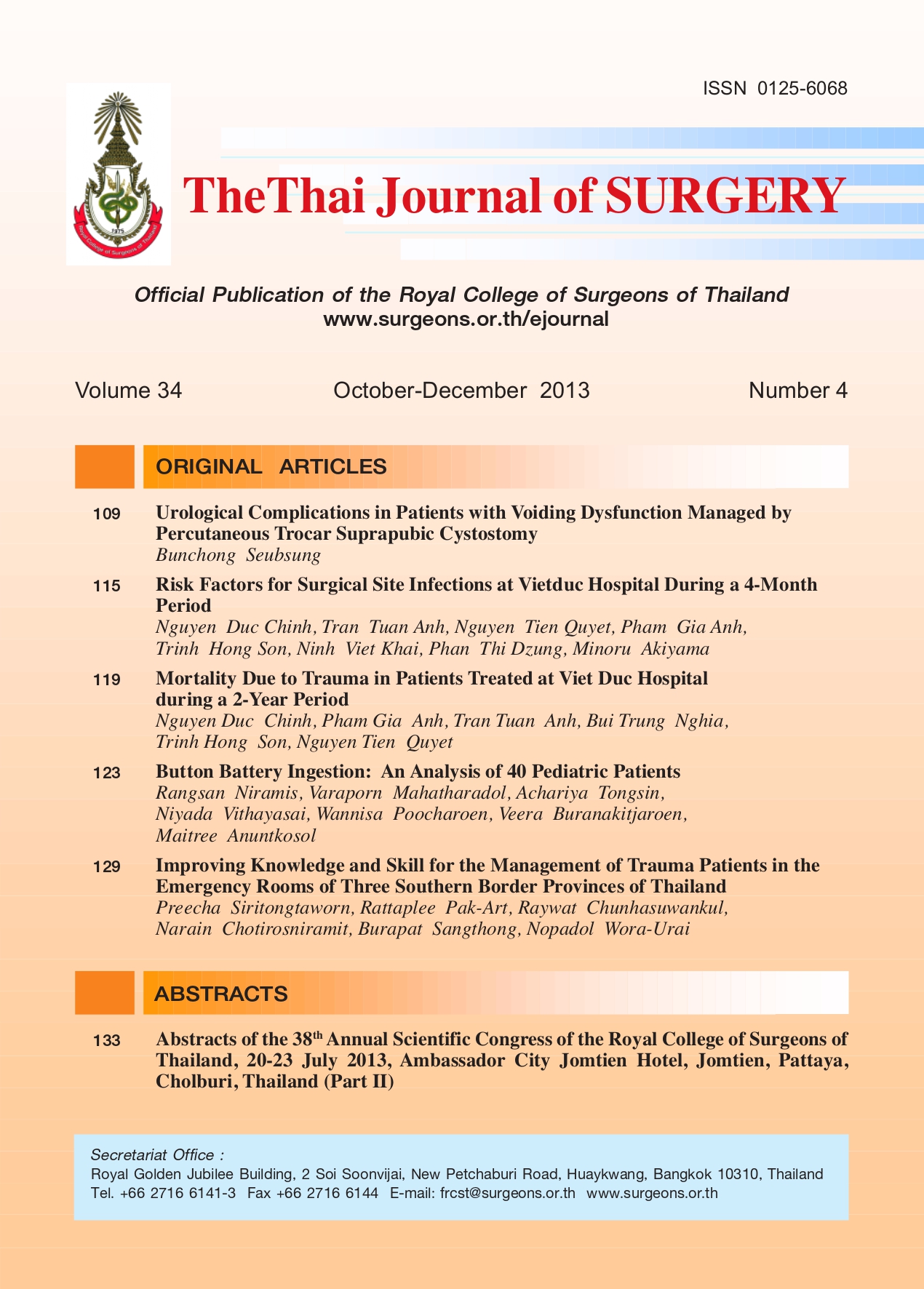Urological Complications in Patients with Voiding Dysfunction Managed by Percutaneous Trocar Suprapubic Cystostomy
Keywords:
Voiding dysfunction, percutaneous trocar suprapubic cystostomy, complication, quality of lifeAbstract
Objective: To study the quality of life and urological complications in patients with voiding dysfunction managedby percutaneous trocar suprapubic cystostomy.
Materials and Methods: A total of 50 patients who underwent percutaneous trocar suprapubic cystostomy (SPC)
between 2006 and 2012 were retrospectively reviewed. Demographic data, comorbidity, urine culture, glomerular
filtration rate (CKD-EPI formula), indication for SPC, complications, and quality of life were compared between
patients who had previous urethral catheterization and those who had SPC.
Results: Glomerular filtration rate before SPC was higher than that after SPC, but not statistically different
(P>0.05). The incidence of symptomatic urinary tract infection (UTI) after SPC was lower than that before SPC (20%
vs 48%), a significant difference (P<0.05). The most common pathogen found on urine culture was Escherichia coli.
Patients’ satisfaction rate for SPC was 86%. Reasons for preference included less frequent symptomatic urinary tract
infection (UTI), less discomfort, easier catheter management, and improved daily activity.
Conclusions: Percutaneous trocar SPC is a simple and effective outpatient procedure for long-term bladder
drainage in patients with voiding dysfunction. But clinicians should be aware of complications related to SPC, and
attempt to reduce these complications. SPC had lower symptomatic urinary tract infection (UTI), and greater patient
satisfaction compared with urethral catheterization.
References
of bladder drainage used in the early care of spinal cord
injury patients. Paraplegia 1985;23:18-26.
2. Noll F, Russe O, Kling E, et al. Intermittent catheterisation
versus percutaneous suprapubic cystostomy in the early
management of traumatic spinal cord lesions. Paraplegia
1988;26:4-9.
3. Barnes DG, Shaw P, Timoney A, et al. Management of the
neuropathic bladder by suprapubic catheterization. Br J
Urol 1993;72:169-72.
4. Nomura S, Ishido T, Teranishi J, et al. long - term analysis of
suprapubic cystostomy drainage in patients with neurogenic
bladder. Urol Int 2000;65:185-9.
5. Mitsui T, Minami K, Furuno T, et al. Is suprapuric cystostomy an
optimal urinary management in high quadriplegics? A
comparative study of suprapubic cystostomy and clean
intermittent catheterization. Eur Urol 2000;38:434-8.
6. McPhail MJ, Abu-Hilal M, Johnson CD. A meta-analysis
comparing suprapubic and transurethral catheterization
for bladder drainage after abdominal surgery. Br J Surg
2006;93:1038-44.
7. Nwadiaro HC, Nnamona MI, Ramyil VM, et al. Comparative
analysis of urethral catheterization versus suprapubic
cystostomy in management of neurogenic bladder in spinal
injured patients. Niger J Med 2010;16: 318-21.
8. Gormley AE. Urologic complications of neurogenic bladder.
Urol Clin North Am 2010;37:601-7.
9. Park HC, Hwan JS, Heun SJ. Rethinking suprapubic cystostomy
in volding dysfunction. Korean J Urol 2010;51: 847-52.
10. Singh R, Rohilla RK, Sangwan K, et al. Bladder management
methods and urological complications in spinal cord injury
patients . Indian J Orthop 2011;45:141-7.
11. Ahluwalia RS, Johal N, Kouriefs C, et al. The surgical risk of
suprapubic catheter insertion and long-term sequelae. Ann
R Coll Surg Engl 2006;88:210-3.
12. Macdiarmid SA, Arnold EP, Palmer NB, et al. Management
of spinal cord injured patients by indwelling suprapubic
catheterization. J Urol 1995;154:492-4.
13. Sheriff MK, Foley S, Mcfarlane J, et al. Long-term suprapubic
catheterization: clinical outcome and satisfaction survey.
Spinal Cord 1998;36:171-6.
14. Khan A, Abrams P. Suprapubic catheter insertion is an
outpatient procedure: cost savings resultant on closing an
audit loop. BJU Int 2009;103:640-4.
15. Geng V, Cobussen-Boekhorst H, Gea-Sanches M, et al.
Evidence-based guidelines for best practice in urological
health care: catheterization indwelling catheters in adults.
Eur Assoc Urol Nurse 2012:48:1-10.
16. Stickler DJ, Feneley RC. The encrustation and blockage of
long-term indwelling bladder catheters: a way forward in
prevention and control. Spinal Cord 2010;48:784-90.
17. Sugimura T, Arnold E, English S, et al. Chronic suprapubic of
patients with spinal cord injuries: analysis of upper and lower
tract complications. BJU Int 2008;101:1396-400.
18. Bothig R, Hirschefld S, Thietje R. Quality of life and urological
morbidity in tetraplegics with artificial ventilation managed
with suprapubic or intermittent catheterization. Spinal Cord
2012;50:247-51.
19. Goyal NK, Goel A, Sankwar SN. Safe percutaneous
suprapubic catheterization. Ann R Coll Surg Engl 2012;94:
597-600.
Downloads
Published
How to Cite
Issue
Section
License
Articles must be contributed solely to The Thai Journal of Surgery and when published become the property of the Royal College of Surgeons of Thailand. The Royal College of Surgeons of Thailand reserves copyright on all published materials and such materials may not be reproduced in any form without the written permission.



